Last Updated on January 22, 2024 by Greg Gillson
If you are only feeding birds birdseed, suet and nectar you are missing out!
There are many colorful summer birds that don’t eat seeds and don’t normally come to your feeders but you can attract them to your yard by offering fruit. You might be surprised what other feeder visitors you may get throughout the year if you put out different fruits.
Which birds eat fruit? Thrushes (including robins and bluebirds), tanagers, thrashers, orioles, jays, mockingbirds, woodpeckers and others will eat fruits. Some birds thought of as seed eaters will enjoy fruit, too.
 |
| Western Tanager eating an orange. Photo by Greg Gillson |
What backyard birds eat fruit?
What kinds of birds eat fruit? Birds that eat primarily fruit are termed frugivorous. Such birds likely also eat insects to supply protein to their diet. Most frugivorous birds, for instance, feed their nestlings primarily insects.
A less common term is baccivorous, describing any animal that eats primarily berries. In North America berries generally appear only briefly some time in summer or fall. Birds that eat berries in summer and fall will eat insects, grubs and other invertebrates the rest of the year. The term for birds that primarily eat insects is insectivorous.
Other birds are omnivorous, eating a wide variety of foods, including insects, grain, small animals, seeds, berries, and fruit. Some omnivorous birds (jays, crows, starlings, grackles) are undesirable as backyard birds because they tend to be aggressive, to be found around human trash, may eat other birds’ eggs or nestlings, and quickly gobble up all the food at bird feeders.
Carnivorous birds, hawks and owls are unlikely to eat fruit.
Granivorous birds, seed eaters such as finches, also eat fruit when available. Apricots, nectarines, peaches, plums, and cherries are some of the orchard fruit crops that House Finches sometimes eat. True insectivorous birds include most flycatchers. Surprisingly, they eat fruit and berries too, but probably rarely at feeders.
Sparrows, buntings, cardinals, and grosbeaks, which eat primarily seeds, feed primarily insects to their young (and also eat insects as adults), and would also occasionally eat fruit. We think of them as seed-eaters, but they have a wider diet.
Tanagers eat primarily insects, but also fruit and berries. They eat oranges, too.
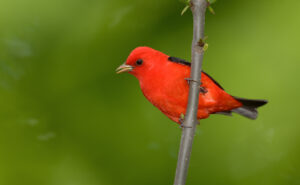
Orioles eat insects, fruit, and nectar. They love oranges!
Thrushes, including bluebirds and American robins eat insects, fruit, and berries. The American Robin eats about 40% invertebrates such as worms, caterpillars, grasshoppers, and about 60% fruit. Catbirds, mockingbirds, and thrashers are omnivores, eating insects and fruit. Up to 50% of the diet of Gray Catbird is fruit and berries.
Waxwings eat insects and berries. They eat fruit such as cherries.
Woodpeckers eat fruit and berries along with their typical insect and nut diet. Red-bellied Woodpeckers visit feeders for fruit. Sapsuckers visit orchards in winter to eat old apples still hanging on the trees.
Warblers eat berries and fruit. Yellow-rumped Warblers, that spend the winter farther north than most others eat berries and fruit in winter.
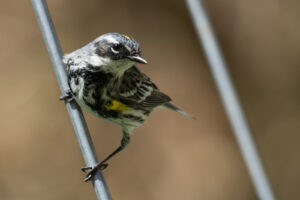
Quails, turkeys, and pheasants will eat berries. If you live on the edge of farmlands you may have these birds visit your backyard.
10 kinds of fruit that birds eat
These are the fruits and the types of birds typically listed as eating them. This is not a complete list.
1. Apples
Birds that eat apples include buntings, cardinals, grosbeaks, mockingbirds, thrashers, waxwings, wrens.
The crabapple is North American’s only native apple. But you may grow apple trees and leave some fruit on the tree for birds in winter. Birds can eat the older rotting apples, but you can also slice ripe ones up and offer them on your feeder.
Some additional specific birds that do eat apples include Eastern Bluebird, Gray Catbird, American Crow, House Finch, Purple Finch, Blue Jay, American Robin, Red-breasted Sapsucker, European Starling, Eastern Towhee, Downy Woodpecker, Hairy Woodpecker, Red-bellied Woodpecker, Red-headed Woodpecker.
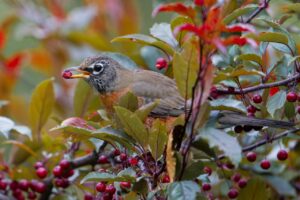
2. Oranges
Birds that eat oranges include bluebirds, catbirds, grosbeaks, mockingbirds, orioles, robins, tanagers, thrashers, towhees, waxwings, woodpeckers.
Many birds can eat oranges. They can be offered as orange-halves or sliced.
Some additional specific birds that do eat oranges include Rose-breasted Grosbeak, Baltimore Oriole, Bullock’s Oriole, Hooded Oriole, Orchard Oriole, Scarlet Tanager, Western Tanager, Brown Thrasher, Red-bellied Woodpecker.
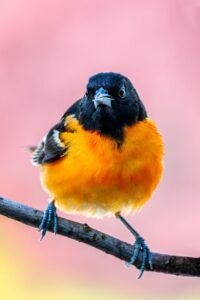
3. Grapes
Birds that eat grapes include bluebirds, catbirds, grosbeaks, mockingbirds, robins, tanagers, towhees, waxwings, woodpeckers.
In many places there grows wild grapes. You may add these to your landscaping. Birds can eat grapes right off the vine! You may cut them in half to make it easier for the birds to eat grapes.
Some additional specific birds that do eat grapes include Northern Cardinal, Northern Flicker, Baltimore Oriole, Scarlet Tanager, Veery, Red-eye Vireo, Downy Woodpecker, Pileated Woodpecker, Red-bellied Woodpecker.
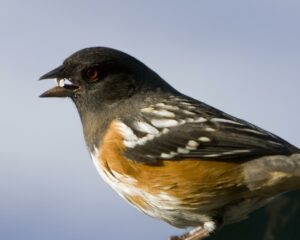
4. Grape jelly
Birds that eat grape jelly include catbirds, orioles, House Finches.
The primary reason birds are drawn to grape jelly is its high sugar content. Sugar provides a quick and readily available source of energy, especially important during migration or breeding seasons when they require extra fuel.
The dark purple color and sweet smell of grape jelly can mimic ripe fruit, attracting birds looking for a natural food source.
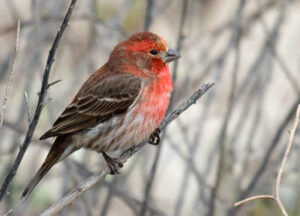
5. Raisins
Birds that eat raisins include bluebirds, catbirds, mockingbirds, orioles, robins, waxwings.
Raisins are dried grapes, concentrated in natural sugars like fructose. This provides birds with a quick energy boost, especially during migration or breeding periods when they need extra fuel.
The chewy texture and sweet aroma of raisins resemble dried fruits birds naturally encounter, making them an appealing snack.
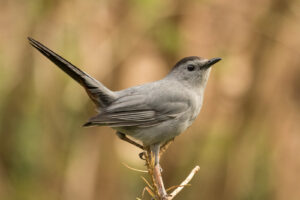
6. Blueberries
Birds that eat blueberries include bluebirds, catbirds, mockingbirds, waxwings.
Blueberries are perfectly sized for many small birds to swallow whole or peck at with ease. This makes them a convenient and accessible source of food.
The bright blue color of blueberries stands out amongst foliage, attracting birds’ attention and signaling a potential food source.
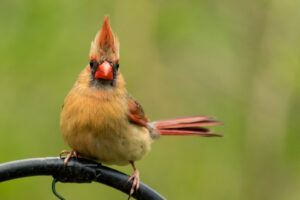
7. Cranberries
Birds that eat cranberries include bluebirds, catbirds, mockingbirds, waxwings.
While cranberries are notoriously tart for human palates, birds have different taste receptors. They can sense the natural sugars (fructose and glucose) present in cranberries, making them more palatable than we perceive.
Like other fruits, cranberries provide a quick source of energy for birds, especially during migration or breeding seasons when their fuel demands are high.
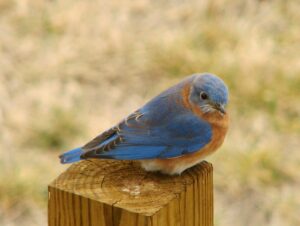
8. Cherries
Birds that eat cherries include bluebirds, catbirds, finches, mockingbirds, waxwings.
Bird feeders shouldn’t contain whole cherries, as the pits can pose a choking hazard. If offering fresh cherries, break them open or cut them into smaller pieces.
While nutritious, cherries are high in sugar and might cause digestive issues if consumed in large quantities by birds. Offer them in moderation as a treat alongside a balanced diet.
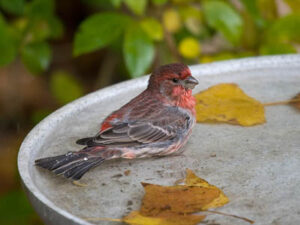
9. Currants
Birds that eat currants include bluebirds, catbirds, mockingbirds, robins, thrushes, waxwings.
Currants aren’t just tart; they also contain natural sugars like fructose and glucose, providing birds with a delightful mix of sweet and sour flavors. This taste complexity can be quite appealing to their palates.
Like many berries, currants offer a quick and readily available energy source for birds, especially during migration or breeding seasons when fuel demands are high.
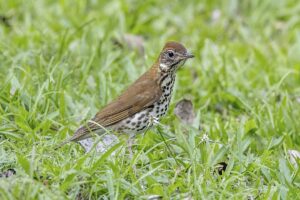
10. Blackberries
Birds that eat blackberries include orioles, waxwings, robins, Western Tanagers, Golden-crowned Sparrows, Spotted Towhees.
Birds play a vital role in spreading blackberry seeds far and wide. By eating the berries and passing the seeds intact through their digestive system, they help the plant reproduce and expand its range, creating more berry patches for future feathered feasts.
Birds attracted to blackberries might also help control harmful insects in your garden, creating a mutually beneficial relationship where everyone wins (except maybe the bugs!).
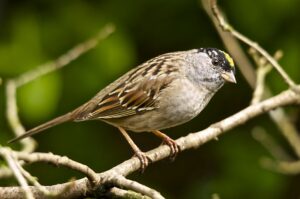
This is not a complete list. What other fruits and berries are sold at your local markets? If you eat them, then birds will eat them. Plums, pears, mangoes, watermelons, pumpkins, squashes, cantaloupes, strawberries, huckleberries, bananas, grapefruits. You no doubt can think of things I’m missing!
You can also plant many trees and bushes that produce berries that birds love. Many of these are not often eaten by people: mulberries, elderberries, holly, Oregon grape, juniper. Many shrubs sold as hedges produce berries that birds will eat. You should check your local nursery for native shrubs that will grow in your area and local birds are already used to eating.
Here is a chart of common fruits fed to birds at feeders and some of the birds noted to frequently eat them.
| Bird | Apples | Oranges | Grapes | Raisins | Cherries |
| bluebirds | yes | yes | yes | yes | yes |
| cardinals | yes | yes | |||
| catbirds | yes | yes | yes | yes | yes |
| finches | yes | yes | |||
| grosbeaks | yes | yes | yes | ||
| mockingbirds | yes | yes | yes | yes | yes |
| orioles | yes | yes | yes | ||
| robins | yes | yes | yes | yes | |
| tanagers | yes | yes | |||
| thrashers | yes | yes | |||
| towhees | yes | yes | yes | ||
| waxwings | yes | yes | yes | yes | |
| woodpeckers | yes | yes | yes |
Note: Many of the lists from which this chart was compiled were created for birds of the Eastern United States. There is every reason to believe western counterparts would equally eat the listed fruits. For instance, “bluebirds” usually refer to Eastern Bluebird. But Western Bluebird and Mountain Bluebird would also likely eat the same fruits. “Cardinals” refer to Northern Cardinal, “catbirds” refer to Gray Catbird, “grosbeaks” refer to Rose-breasted Grosbeak, “mockingbirds” refer to Northern Mockingbird, “orioles” refer to Baltimore Oriole, “robins” refer to American Robin, “tanagers” refer to Scarlet Tanager, “thrashers” refer to Brown Thrasher, “towhees” refer to Eastern Towhee, “waxwings” refer to Cedar Waxwing, “woodpeckers” refer to Red-bellied Woodpecker.
How to feed birds fruit
How to prepare fruit for birds
The easiest way to prepare either fresh or dried fruit for birds is to cut it in pieces. You should try both larger and smaller pieces of fruit to see if any birds prefer one size over another.
Oranges may be offered in sections. However, they are often offered by cutting in half crosswise. Do not peel. Similarly, apples may be offered cut into slices or the apple may be cut in half lengthwise. Do not peel or core.
Raisins and dried fruits like cranberries can be soaked in water over night before being offered to birds. Commercial dried fruit: some bird foods at your local market may offer a “nut, fruit & berry” blend. These are made for hopper and platform bird feeders. There may also be “tropical fruit” bird foods prepared for parrots that wild birds may eat.
How to offer fruit to birds
Fruit may be placed out directly on the ground or on the tray of your platform bird feeder. Better, cut up pieces may be placed in a small glass bowl so it isn’t scattered about.
However, there is always the risk that a jay or crow will come by and snatch all the fruit and carry it off. Thus, it may be prudent to contain or hold down the fruit. How?
Mesh “onion bags” may be used to keep fruit in. Birds will then pull individual pieces through. [See warning from reader in comments below about birds potentially getting caught in these bags.]
In summer it is too hot to feed suet. Instead, clean up those metal suet cages and fill with larger pieces of fruit for the birds to nibble on. [Also see comments section below for feeding suet in warmer temperatures. A suet cage is still a practical way to offer fruit to birds.]
Oranges and apples may be cut in half and impaled on a tree branch, nail, or special “oriole” bird feeder equipped with a spike to hold fruit.
A project perhaps for the young, you may “sew” pieces of fruit onto thread and make a garland to drape over a bush or small tree.
How to feed birds fruit cheaply from kitchen scraps
When you wash purple concord grape clusters (I don’t think many birds will eat green varieties of grapes) you’ll find bruised, split, and some with crusty scabs sometimes. Instead of throwing them out, feed them to the birds!
Sometimes you get bags of oranges and find many are unripe and tasteless. They sit on your counter hoping to ripen. But eventually they get soft on the bottom before they get edible. Instead of throwing them out, cut them in half and give them to the birds!
The same is true of most other fruit.
Save the seeds from pumpkins, squashes, and melons to feed the birds.
The rinds of melons with some flesh still attached can be saved for birds.
Pick up any windfall fruit you find. Cut away the bruises and feed the rest of it to the birds.
Freeze excess summer and fall fruit to feed birds in winter.
Other considerations
Don’t feed birds spoiled or fermented food. If it has mold on it, throw it away (or compost it). Do not leave spoiled fruit out where it will attract pests.
Perhaps more than other foods you may feed birds, fruit will go bad fast. Be prepared to remove it from your feeder when it goes bad. This is why it may be good to freeze excess fruit and only put out as much fruit as the birds will eat in a day or two.
If you don’t clean up the fruit, or put too much out at once, you’ll soon have ants and insect pests, rodents, raccoons, opossums, skunks, dogs, coyotes, or bears visiting! For this reason feed fruit farther away from your house, to keep pests away.
Frequently Asked Questions
Do wild birds like dried fruit?
Yes and actually, using dried fruit on a feeder is a good idea as it spoils less easily and lasts longer.
You will see on my list I have included raisins and currants.
Can birds eat Cheerios?
Yes, but I’m not sure why anyone would put them on a bird feeder.
The food we give birds should reflect what they can find naturally. That is why using fruit is such as good idea.
What food poisons birds?
Several foods can be harmful or even poisonous to birds, making it crucial to be mindful of what you offer them in your backyard or feeders. Here are some common culprits to avoid:
Foods inherently toxic to birds:
- Avocado: The leaves, fruit, stems, bark, and seeds of avocado contain persin, a fatty acid-like toxin that can damage a bird’s heart muscle and respiratory system.
- Chocolate: Both cocoa and theobromine found in chocolate are toxic to birds, even in small amounts. They can cause tremors, seizures, heart problems, and even death.
- Coffee and tea: Similarly, caffeine in coffee and tea can negatively affect birds’ hearts and nervous systems.
- Fruit pits and seeds: Certain fruit pits and seeds, like those from apples, cherries, peaches, and apricots, contain small amounts of cyanide, which can be lethal for birds.
- Rhubarb leaves: These leaves contain oxalic acid, which can damage a bird’s kidneys and other organs.
- Salt: Excessive salt intake can lead to dehydration and electrolyte imbalance in birds.
- Moldy or fermented food: Spoiled food can harbor harmful bacteria and toxins that can make birds sick.
Related Articles:
Thistle and the birds that eat it



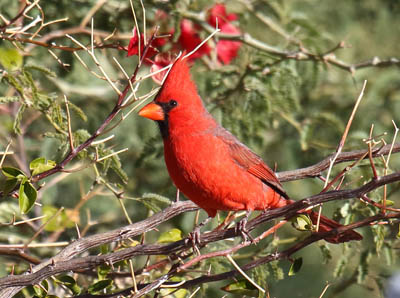
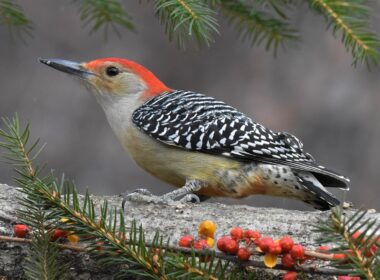
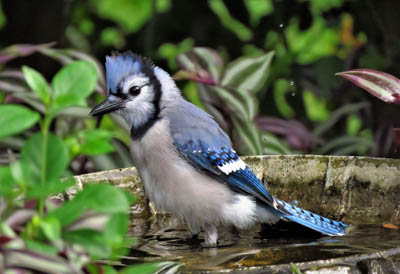
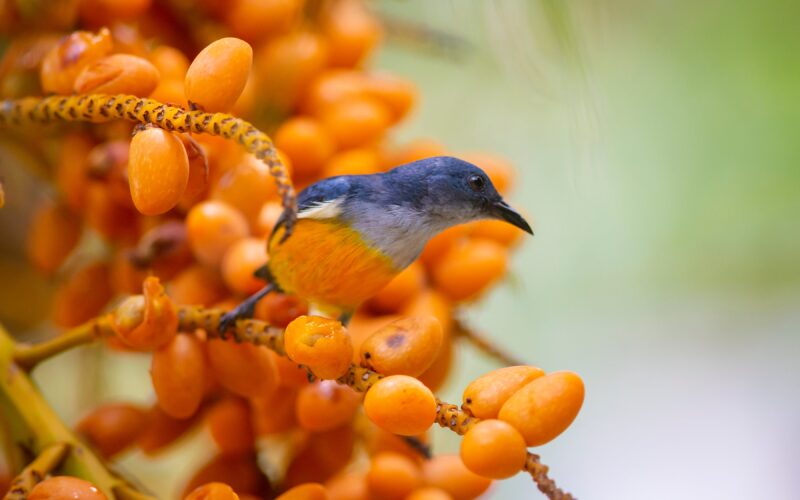
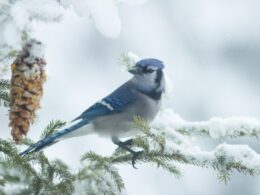
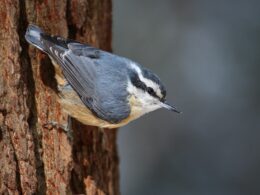
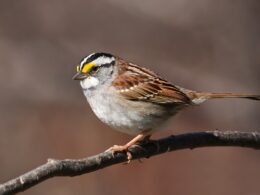
Thank you so much for the information. It is very helpful as I have been trying to come up with various ways of feeding my benches and small birds that come to my backyard. I live out west, in Las Vegas Nevada, but I’m going to try some of your methods to offer the birds more variety than just seed. Thanks again your post was very helpful.
Thank you. Your finches and small birds will love it! You'll find out what works and what doesn't, too.
Hi. Just a moment ago I saw a rose-breasted grosbeak eat grape jelly from my feeder. Guess you can add it to the list of jelly eaters!
Wow, that's great, Liz!
Thanks for taking the time to say hi!
i planted a blackberry bush because im a baker. but the birds love it so much i just leave the fruit on there for them. you should definitely plant a black berry bush for them. they grow like crazy so you dont have to do anything special to get them to bear fruit.
Blackberry bushes grow wild in Oregon and Washington and really attract birds! Thanks for sharing, Jaycee.
finches devour my jelly
Thanks for the report on grape jelly and House Finches!
I just had a hummingbird suck from a ripe fig still hanging in the tree. never saw this before
That does seem unusual, Pat. Thanks for sharing!
I was given strawberries for Thanksgiving. I will not eat them. I'm picky about that, will eat only in season from my daughter's farm. so is it safe to put them out for the birds? I cannot find info anywhere on strawberries being safe for WINTER birds…. thanks!!!
Strawberries should be cut up and fed to birds from a bowl or something similar. I haven't heard specifically of this fruit. But there is nothing wrong with it for birds. I expect robins would eat it, perhaps house finches and jays and starlings.
Please, don't use mesh onion bags. Birds can tangle up their legs in them, get stuck and die.
Thank you for that warning. I have not heard this before. So if anyone has some specific data on this I'd love to hear.
Thanks about the oranges I didn't know.can I use suet balls been told not to.
I bought a bag of small oranges. I like the sour little ones, not the big sweet ones. But most of the oranges were tasteless. Peeled and sectioned them. Put in bag in the freezer.
With the snow out this weekend, I put out the oranges and they are a hit! Pine Siskins and Varied Thrushes are really eating them!
There is nothing wrong with suet balls. Suet provides badly needed calories in this cold weather.
Very informative, thanks. One incorrect statement is that "it is too hot in the summer for suet". We live in West Tennessee; Jackson, it is hot and humid. Average temp/humidity: June 86°/76%, July 90°/78%, August 89°/76%. I feed suet daily. I have 5 suet feeders, I cut a cake into 8 sections and put 1 section each day in the suet cage. A day does not go by that no suet is eaten. Occasionally a piece will go 2 days. I generally switch over to no-melt suet to keep my fingers from being greasy. For variety I'll use a berry or apple cake every once-in-a-while. I like the idea of using fruit in a suet feeder so I will try offering fruit in it as well. Thanks again!
Thank you for visiting, TN Gardener!
Thanks for your description of how you offer suet.
Your summer temperatures are nice, but that high humidity!
When summertime temperatures average over 80F for several days, most people recommend removing suet. It can melt and make a mess or go rancid quickly.
The Cornell Lab on it's web site says there are some suet manufacturers that claim 100F is okay for theirs. But The Lab does give a warning.
And they say that raw or homemade suet should not be fed in summer.
Read about it here.
https://www.allaboutbirds.org/news/should-i-take-my-feeder-down-when-the-weather-starts-to-warm-up
Those offering suet should use common sense and check out their suet. Makes sure it isn't a melting mess or rancid. If it goes bad quickly, wait to offer it until the temperatures go back down in the fall.
We buy seedless green grapes, and any soft or mushy ones get tossed outside for the robins. Others robins will often chase the "lucky" bird, back and forth across the yard, hoping to steal it.
Perfect. Thanks for that data point.
Loved this article and I am so excited to use this knowledge. Your posts have helped me greatly to understand what kind of feeds for what kind of birds, what specific birds enjoy to eat, importance of water baths, etc. Thank you for all the enjoyment you have added to our lives.
My pleasure!
This is a great help. Do you have any ideas for birds in Australia
I’m getting ready for our summer coming up
From Cindy
I keep my suet cakes in a fridge in my garage. Keeps them firm enough to handle
Sorry, I don't have any specific ideas for birds of Australia. But there should be many that will eat these same fruits.